The Effect of the Addition of Copper Particles in High-Density Recycled Polyethylene Matrices by Extrusion
Abstract
1. Introduction
2. Methodology
2.1. High-Density Polyethylene
2.2. Synthesis of Copper Particles
2.3. Incorporation of Copper Particles on HDPE by Extrusion
2.4. Morphological Characterization
2.5. Differential Scanning Calorimetry and Thermogravimetric Measurements
2.6. Tensile Testing
2.7. Antibacterial Properties
3. Results and Discussion
3.1. Morphological Characterization
3.2. Differential Scanning Calorimetry and Thermogravimetric Measurements
3.3. Mechanical Characterization
3.4. Antibacterial Properties
4. Conclusions
Supplementary Materials
Author Contributions
Funding
Data Availability Statement
Acknowledgments
Conflicts of Interest
References
- Alimba, C.G.; Faggio, C. Microplastics in the marine environment: Current trends in environmental pollution and mechanisms of toxicological profile. Environ. Toxicol. Pharmacol. 2019, 68, 61–74. [Google Scholar] [CrossRef] [PubMed]
- Plastics Europe. Plastics—The Facts 2021, Brussels, 2021. Available online: https://plasticseurope.org/knowledge-hub/plastics-the-facts-2021/ (accessed on 30 September 2022).
- Geyer, R. Production, use, and fate of synthetic polymers. In Plastic Waste and Recycling; Academic Press: London, UK, 2020; pp. 13–32. [Google Scholar] [CrossRef]
- Un Environment Programme. THE STATE OF PLASTICS–World Environment Day Outlook 2018. 2018. Available online: https://www.unep.org/resources/report/state-plastics-world-environment-day-outlook-2018 (accessed on 30 September 2022).
- Singh, P.; Sharma, V. Integrated Plastic Waste Management: Environmental and Improved Health Approaches. Procedia Environ. Sci. 2016, 35, 692–700. [Google Scholar] [CrossRef]
- Ferdous, W.; Manalo, A.; Siddique, R.; Mendis, P.; Zhuge, Y.; Wong, H.S.; Lokuge, W.; Aravinthan, T.; Schubel, P. Recycling of landfill wastes (tyres, plastics and glass) in construction—A review on global waste generation, performance, application and future opportunities. Resour. Conserv. Recycl. 2021, 173, 105745. [Google Scholar] [CrossRef]
- Geyer, R.; Jambeck, J.R.; Law, K.L. Production, use, and fate of all plastics ever made. Sci. Adv. 2017, 3, e1700782. [Google Scholar] [CrossRef]
- UN Environment. Perspectivas del Medio Ambiente Mundial, GEO-6, 2019. Available online: https://www.miteco.gob.es/es/ceneam/recursos/pag-web/geo6.aspx (accessed on 30 September 2022).
- Anderse, I.; UN Environment Programme. Annual UN Environment Programme, 2021. Available online: https://wedocs.unep.org/bitstream/handle/20.500.11822/37946/UNEP_AR2021.pdf (accessed on 17 September 2022).
- Mondal, M.; Bose, B.; Bansal, P. Recycling waste thermoplastic for energy efficient construction materials: An experimental investigation. J. Environ. Manag. 2019, 240, 119–125. [Google Scholar] [CrossRef] [PubMed]
- Wulan, S.; Rukmana, D.; Sjahrul, M. Utilization of Solid Waste from Refined Sugar Industry (Filter Cake) as Biodegradable Foam (Biofoam). IOP Conf. Ser. Earth Environ. Sci. 2020, 473, 012108. [Google Scholar] [CrossRef]
- Crawford, C.B.; Quinn, B. Plastic production, waste and legislation. In Microplastic Pollutants; Elsevier: Amsterdam, The Netherlands, 2017; pp. 39–56. [Google Scholar] [CrossRef]
- Association of Plastic Manufacturers Europe. An Analysis of European Plastics Production, Demand and Waste Data, Brussels, 2015. Available online: https://plasticseurope.org/wp-content/uploads/2021/10/2015-Plastics-the-facts.pdf (accessed on 17 September 2022).
- Todd, S.M. Joining Thermoplastic Composites. In High Performance Thermoplastic Resins and their composites, 2nd ed.; Béland, S., Ed.; William Andrew: New York, USA, 1990; pp. 125–135. [Google Scholar] [CrossRef]
- Yousefpour, A.; Hojjati, M.; Immarigeon, J.-P. Fusion Bonding/Welding of Thermoplastic Composites. J. Thermoplast. Compos. Mater. 2004, 17, 303–341. [Google Scholar] [CrossRef]
- Van der Ven, S. Polypropylene and Other Polyolefins. In Brydson’s Plastics Materials (Eighth Edition), 2nd ed.; Gahleitner, M., Paulik, C., Eds.; Butterworth-Heinemann: Oxford, UK, 2017; pp. 279–309. [Google Scholar] [CrossRef]
- Tamayo, L.; Azócar, M.; Kogan, M.; Riveros, A.; Páez, M. Copper-polymer nanocomposites: An excellent and cost-effective biocide for use on antibacterial surfaces. Mater. Sci. Eng. C 2016, 69, 1391–1409. [Google Scholar] [CrossRef]
- Badrossamay, M.R.; Sun, G. Preparation of rechargeable biocidal polypropylene by reactive extrusion with diallylamino triazine. Eur. Polym. J. 2008, 44, 733–742. [Google Scholar] [CrossRef]
- Nemerow, N.L.; Agardy, F.J.; Sullivan, P.; Salvato, J.A. Environmental Health and Safety for Municipal Infrastructure, Land Use and Planning, and Industry, Sixth Edition. In Environmental Engineering, 2nd ed.; Wiley: New York, NY, USA, 2009; pp. 429–524. [Google Scholar] [CrossRef]
- Bikiaris, D.N.; Triantafyllidis, K.S. HDPE/Cu-nanofiber nanocomposites with enhanced antibacterial and oxygen barrier properties appropriate for food packaging applications. Mater. Lett. 2013, 93, 1–4. [Google Scholar] [CrossRef]
- Widmer, A.F.; Kuster, S.; Dangel, M.; Jäger, S.; Frei, R. Long-term antimicrobial effectiveness of a silver-impregnated foil on high-touch hospital surfaces in patient rooms. Antimicrob. Resist. Infect. Control 2021, 10, 120. [Google Scholar] [CrossRef] [PubMed]
- Jabłońska-Trypuć, A.; Makuła, M.; Włodarczyk-Makuła, M.; Wołejko, E.; Wydro, U.; Serra-Majem, L.; Wiater, J. Inanimate Surfaces as a Source of Hospital Infections Caused by Fungi, Bacteria and Viruses with Particular Emphasis on SARS-CoV-2. Int. J. Environ. Res. Public Health 2022, 19, 8121. [Google Scholar] [CrossRef] [PubMed]
- Rahimi, A.; García, J.M. Chemical recycling of waste plastics for new materials production. Nat. Rev. Chem. 2017, 1, 0046. [Google Scholar] [CrossRef]
- Plastics Recycling Worldwide: Current Overview and Desirable Changes, (n.d.). Available online: https://journals.openedition.org/factsreports/5102#ftn1 (accessed on 30 January 2020).
- SINGLE-USE PLASTICS A Roadmap for Sustainability, n.d. Available online: https://www.unep.org/resources/report/single-use-plastics-roadmap-sustainability (accessed on 17 September 2022).
- ASIPLA, ESTUDIO SOBRE RECICLAJE DE PLÁSTICOS EN CHILE, 2019. Available online: http://www.asipla.cl/wp-content/uploads/2019/04/190328-Estudio-sobre-Reciclaje-de-Pl%C3%A1sticos-en-Chile-Resumen-Ejecutivo.pdf (accessed on 21 July 2020).
- Muñoz-Bonilla, A.; Fernández-García, M. Polymeric materials with antimicrobial activity. Prog. Polym. Sci. 2012, 37, 281–339. [Google Scholar] [CrossRef]
- World Health Organization (WHO). New Report Calls for Urgent Action to Avert Antimicrobial Resistance Crisis. 2019. Available online: https://www.who.int/news-room/detail/29-04-2019-new-report-calls-for-urgent-action-to-avert-antimicrobial-resistance-crisis (accessed on 5 August 2020).
- Jardón-Maximino, N.; Pérez-Alvarez, M.; Cadenas-Pliego, G.; Lugo-Uribe, L.E.; Cabello-Alvarado, C.; Mata-Padilla, J.M.; Barriga-Castro, E.D. Synthesis of Copper Nanoparticles Stabilized with Organic Ligands and Their Antimicrobial Properties. Polymers 2021, 13, 2846. [Google Scholar] [CrossRef]
- Tsao, C.-W.; DeVoe, D. Bonding of thermoplastic polymer microfluidics. Microfluid. Nanofluidics 2008, 6, 1–16. [Google Scholar] [CrossRef]
- Xue, Y.; Xiao, H.; Zhang, Y. Antimicrobial Polymeric Materials with Quaternary Ammonium and Phosphonium Salts. Int. J. Mol. Sci. 2015, 16, 3626–3655. [Google Scholar] [CrossRef]
- Majumdar, P.; Lee, E.; Gubbins, N.; Stafslien, S.J.; Daniels, J.; Thorson, C.J.; Chisholm, B.J. Synthesis and antimicrobial activity of quaternary ammonium-functionalized POSS (Q-POSS) and polysiloxane coatings containing Q-POSS. Polymer 2009, 50, 1124–1133. [Google Scholar] [CrossRef]
- Damayanti, D.; Saputri, D.R.; Marpaung, D.S.S.; Yusupandi, F.; Sanjaya, A.; Simbolon, Y.M.; Asmarani, W.; Ulfa, M.; Wu, H.-S. Current Prospects for Plastic Waste Treatment. Polymers 2022, 14, 3133. [Google Scholar] [CrossRef]
- ASTM. ASTM D638 Standard Test Method for Tensile Properties of Plastics, 2014. Available online: https://www.astm.org/d0638-14.html (accessed on 4 September 2022).
- ASTM. ASTM D2240 Standard Test Method for Rubber Property—Durometer Hardness, 2021. Available online: https://www.astm.org/d2240-15r21.html (accessed on 4 September 2022).
- ISO. ISO 868 Plastics and Ebonite. Determination of Indentation Hardness by Means of a Durometer (Shore Hardness), 2003. Available online: https://www.en-standard.eu/bs-en-iso-868-2003-plastics-and-ebonite-determination-of-indentation-hardness-by-means-of-a-durometer-shore-hardness/?gclid=CjwKCAjwvNaYBhA3EiwACgndgtTi9QrsDJyPYAc717el_jDHGP_SpoFaP6LHHke-5kkuAtK11aR7dRoCiXkQAvD_BwE (accessed on 4 September 2022).
- ASTM. ASTM E2180-01 Determining the Activity of Incorporated antimicrobial Angent(s) in Polymerix or Hydrophobic Materials, 2010. Available online: https://compass.astm.org/document/?contentCode=ASTM%7CE2180-01%7Cen-US (accessed on 18 September 2022).
- Gao, W.; Li, Y.; Zhao, J.; Zhang, Z.; Tang, W. Influence of surface modification of zinc oxide on physical properties of high density polyethylene. Colloids Surf. A Physicochem. Eng. Asp. 2022, 653, 130000. [Google Scholar] [CrossRef]
- Cuadri, A.; Martín-Alfonso, J. The effect of thermal and thermo-oxidative degradation conditions on rheological, chemical and thermal properties of HDPE. Polym. Degrad. Stab. 2017, 141, 11–18. [Google Scholar] [CrossRef]
- Muniyandi, S.K.; Sohaili, J.; Hassan, A. Mechanical, thermal, morphological and leaching properties of nonmetallic printed circuit board waste in recycled HDPE composites. J. Clean. Prod. 2013, 57, 327–334. [Google Scholar] [CrossRef]
- Pontón, P.I.; Yamada, K.; Guamán, M.V.; Johnson, M.B.; White, M.A.; Pandoli, O.; Costa, A.M.; Marinkovic, B.A. The effect of titanate nanotube/Y2W3O12 hybrid fillers on mechanical and thermal properties of HDPE-based composites. Mater. Today Commun. 2019, 18, 124–135. [Google Scholar] [CrossRef]
- Nabiyev, A.; Olejniczak, A.; Pawlukojc, A.; Balasoiu, M.; Bunoiu, M.; Maharramov, A.; Nuriyev, M.; Ismayilova, R.; Azhibekov, A.; Kabyshev, A.; et al. Nano-ZrO2 filled high-density polyethylene composites: Structure, thermal properties, and the influence γ-irradiation. Polym. Degrad. Stab. 2020, 171, 109042. [Google Scholar] [CrossRef]
- Anu, M.; Pillai, S.S. Structure, thermal, optical and dielectric properties of SnO2 nanoparticles-filled HDPE polymer. Solid State Commun. 2022, 341, 114577. [Google Scholar] [CrossRef]
- Pavoski, G.; Kalikoski, R.; Souza, G.; Baldisserotto, D.; Brum, L.F.; Dos Santos, C.; Bergmann, C.; Brandelli, A.; Jacobi, M.; Galland, G. Antimicrobial High-Density Polyethylene (HDPE)/ZnO Nanocomposites Obtained by in situ Polymerization. J. Braz. Chem. Soc. 2020, 31, 1566–1574. [Google Scholar] [CrossRef]
- Tanniru, M.; Yuan, Q.; Misra, R. On significant retention of impact strength in clay–reinforced high-density polyethylene (HDPE) nanocomposites. Polymer 2006, 47, 2133–2146. [Google Scholar] [CrossRef]
- Veliz, A.B.L.; Jiménez, J.C.; López, P.; De Gáscue, B.R. Biodegradability Study by FTIR and DSC of Polymers Films Based on Polypropylene and Cassava Starch. Orbital: Electron. J. Chem. 2019, 11, 71–82. [Google Scholar] [CrossRef]
- Araujo, J.; Waldman, W.; De Paoli, M.-A. Thermal properties of high density polyethylene composites with natural fibres: Coupling agent effect. Polym. Degrad. Stab. 2008, 93, 1770–1775. [Google Scholar] [CrossRef]
- Yusof, M.A.; Rahman, N.H.N.; Sulaiman, S.Z.; Sofian, A.H.; Desa, M.S.Z.M.; Izirwan, I. Development of low density polyethylene/graphene nanoplatelets with enhanced thermal properties. In Proceedings of the 2018 IEEE 9th International Conference on Mechanical and Intelligent Manufacturing Technologies, Cape Town, South Africa, 10–13 February 2018; pp. 6–9. [Google Scholar] [CrossRef]
- de Brito, E.B.; Tienne, L.G.P.; Cordeiro, S.B.; Marques, M.D.F.V.; Monteiro, S.N. The influence of steam explosion treatment of green coffee cake on the thermal and mechanical properties of reinforced polypropylene matrix composites. J. Mater. Res. Technol. 2020, 9, 4051–4060. [Google Scholar] [CrossRef]
- Madi, N. Thermal and mechanical properties of injection molded recycled high density polyethylene blends with virgin isotactic polypropylene. Mater. Des. 2013, 46, 435–441. [Google Scholar] [CrossRef]
- Jeziorska, R.; Szadkowska, A.; Zielecka, M.; Wenda, M.; Kepska, B. Morphology and thermal properties of HDPE nanocomposites: Effect of spherical silica surface modification and compatibilizer. Polym. Degrad. Stab. 2017, 145, 70–78. [Google Scholar] [CrossRef]
- Jeziórska, R.; Zielecka, M.; Gutarowska, B.; Żakowska, Z. High-Density Polyethylene Composites Filled with Nanosilica Containing Immobilized Nanosilver or Nanocopper: Thermal, Mechanical, and Bactericidal Properties and Morphology and Interphase Characterization. Int. J. Polym. Sci. 2014, 2014, 183724. [Google Scholar] [CrossRef]
- Mahmoud M., E.; Khalifa, M.A.; Youssef, M.R.; El-Sharkawy, R.M. Influence of MgO and ZnO as nano-additives on the mechanical, microstructural and thermal performance of high-density polyethylene. J. Appl. Polym. Sci. 2022, 139, e52705. [Google Scholar] [CrossRef]
- Reda, A.M.; A Kansouh, W.; A Eid, E. Effect of Fe2O3/Al addition on the neutron shielding, microstructure, thermal, and mechanical properties of HDPE composites. Phys. Scr. 2022, 97, 065301. [Google Scholar] [CrossRef]
- Beigloo, J.G.; Eslam, H.K.; Hemmasi, A.H.; Bazyar, B.; Ghasemi, I. Effect of Nanographene on Physical, Mechanical, and Thermal Properties and Morphology of Nanocomposite Made of Recycled High Density Polyethylene and Wood Flour. BioResources 2017, 12, 1382–1394. Available online: https://ojs.cnr.ncsu.edu/index.php/BioRes/article/view/BioRes_12_1_1382_Ghaje_Nanographene_Morphology_Nanocomposite_Recycled_Polyethylene (accessed on 6 October 2022).
- Singh, S.; Deepak, D.; Aggarwal, L.; Gupta, V. Tensile and Flexural Behavior of Hemp Fiber Reinforced Virgin-recycled HDPE Matrix Composites. Procedia Mater. Sci. 2014, 6, 1696–1702. [Google Scholar] [CrossRef]
- Tesfaw, S.; Bogale, T.M.; Fatoba, O. Evaluation of tensile and flexural strength properties of virgin and recycled high-density polyethylene (HDPE) for pipe fitting application. Mater. Today Proc. 2022, 62, 3103–3113. [Google Scholar] [CrossRef]
- Basilia, B.A.; Mendoza, H.D.; Cada, L.G. Synthesis and Characterization of RPET/Organo-Montmorillonite Nanocomposites. Philipp. Eng. J. 2002, 23, 19–34. Available online: https://sciencediliman.upd.edu.ph/index.php/pej/article/view/2377 (accessed on 6 October 2022).
- Giraldi, A.L.F.D.M.; Bizarria, M.T.M.; Silva, A.A.; Velasco, J.I.; D’ávila, M.A.; Mei, L.H.I. Effects of extrusion conditions on the properties of recycled poly(ethylene terephthalate)/nanoclay nanocomposites prepared by a twin-screw extruder. J. Appl. Polym. Sci. 2008, 108, 2252–2259. [Google Scholar] [CrossRef]
- Zare, Y. Recent progress on preparation and properties of nanocomposites from recycled polymers: A review. Waste Manag. 2013, 33, 598–604. [Google Scholar] [CrossRef] [PubMed]
- Kulkarni, P.; Ravekar, V.; Rao, P.R.; Waigokar, S.; Hingankar, S. Recycling of waste HDPE and PP plastic in preparation of plastic brick and its mechanical properties. Clean. Mater. 2022, 5, 100113. [Google Scholar] [CrossRef]
- Rao, B.D.; Pradhan, A.; Sethi, K.K. Study of wear performance and mechanical properties of HDPE on addition of CNT fillers. Mater. Today Proc. 2022, 62, 7501–7508. [Google Scholar] [CrossRef]
- Vázquez, K.; Vanegas, P.; Cruzat, C.; Novoa, N.; Arrué, R.; Vanegas, E. Antibacterial and Antifungal Properties of Electrospun Recycled PET Polymeric Fibers Functionalized with Zinc Oxide Nanoparticles. Polymers 2021, 13, 3763. [Google Scholar] [CrossRef]
- Zamindar, N.; Anari, E.S.; Bathaei, S.S.; Shirani, N.; Tabatabaei, L.; Mahdavi-Asl, N.; Khalili, A.; Paidari, S. Application of Copper Nano Particles in Antimicrobial Packaging: A Mini Review. Acta Sci. Nutr. Health 2020, 4, 14–18. [Google Scholar] [CrossRef]
- Shankar, S.; Teng, X.; Rhim, J.-W. Properties and characterization of agar/CuNP bionanocomposite films prepared with different copper salts and reducing agents. Carbohydr. Polym. 2014, 114, 484–492. [Google Scholar] [CrossRef]
- Arfat, Y.A.; Ejaz, M.; Jacob, H.; Ahmed, J. Deciphering the potential of guar gum/Ag-Cu nanocomposite films as an active food packaging material. Carbohydr. Polym. 2016, 157, 65–71. [Google Scholar] [CrossRef]
- Chatterjee, A.K.; Chakraborty, R.; Basu, T. Mechanism of antibacterial activity of copper nanoparticles. Nanotechnology 2014, 25, 135101. [Google Scholar] [CrossRef]
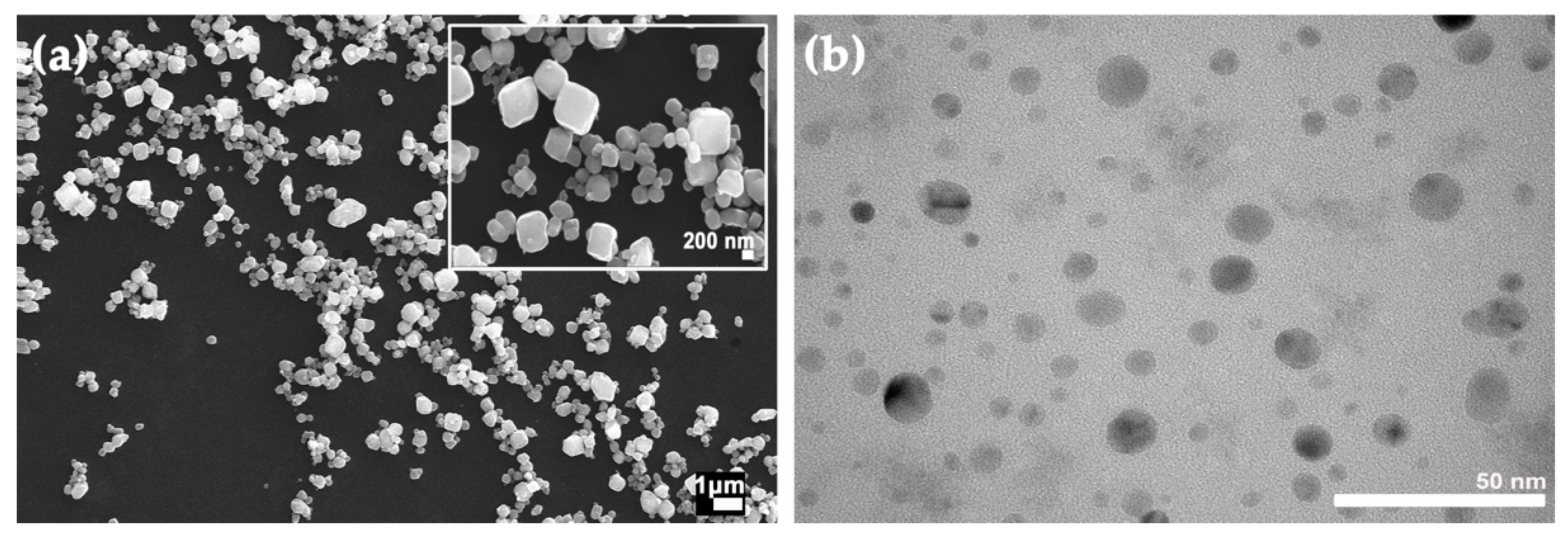

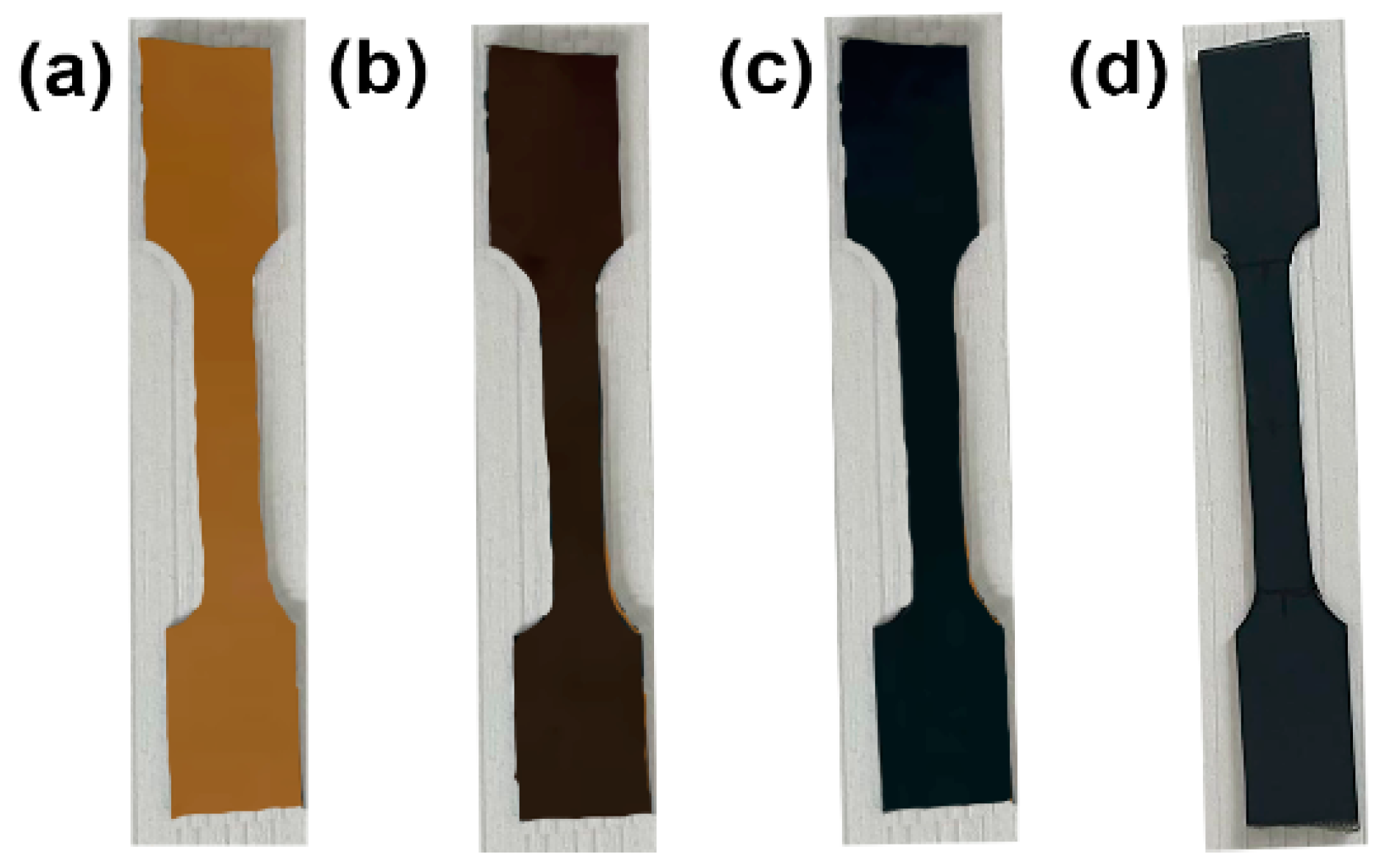
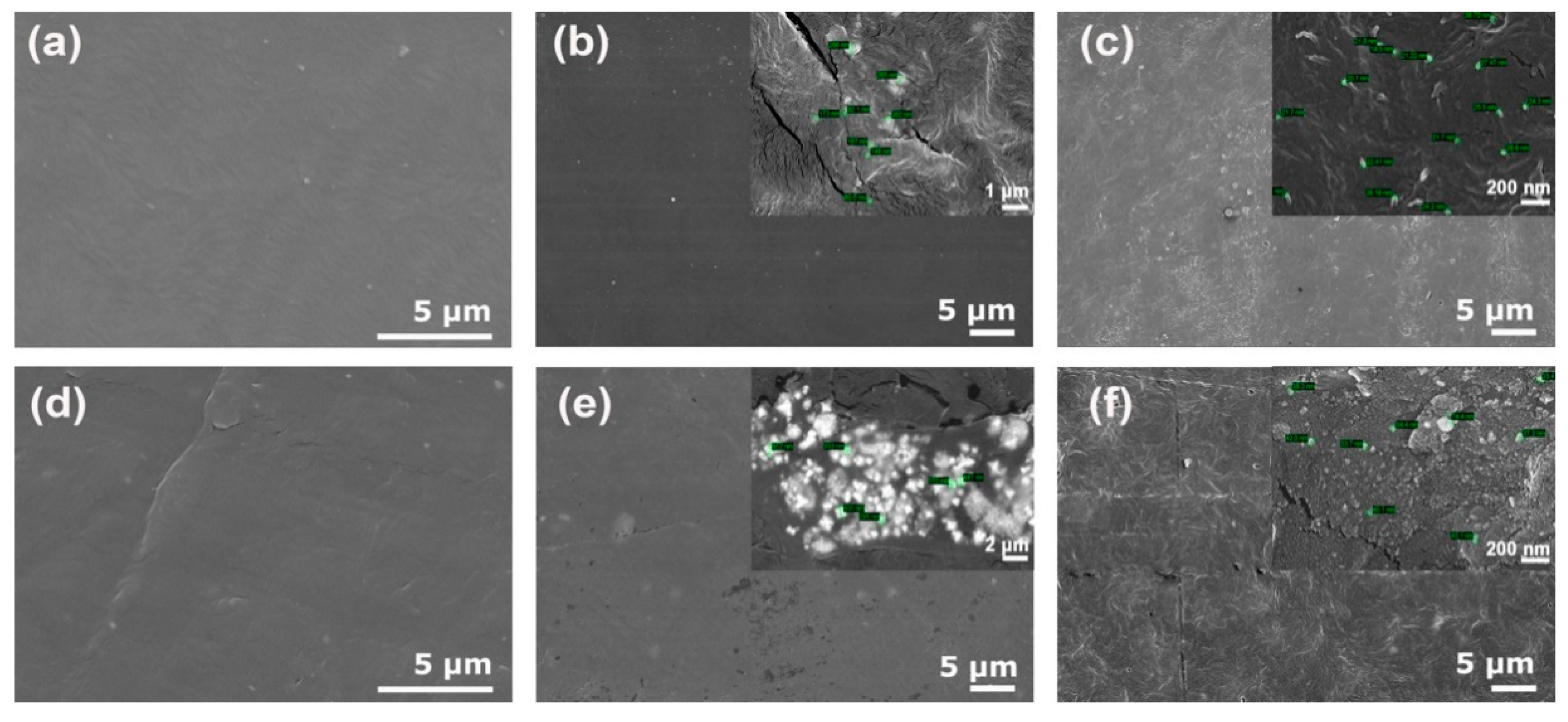
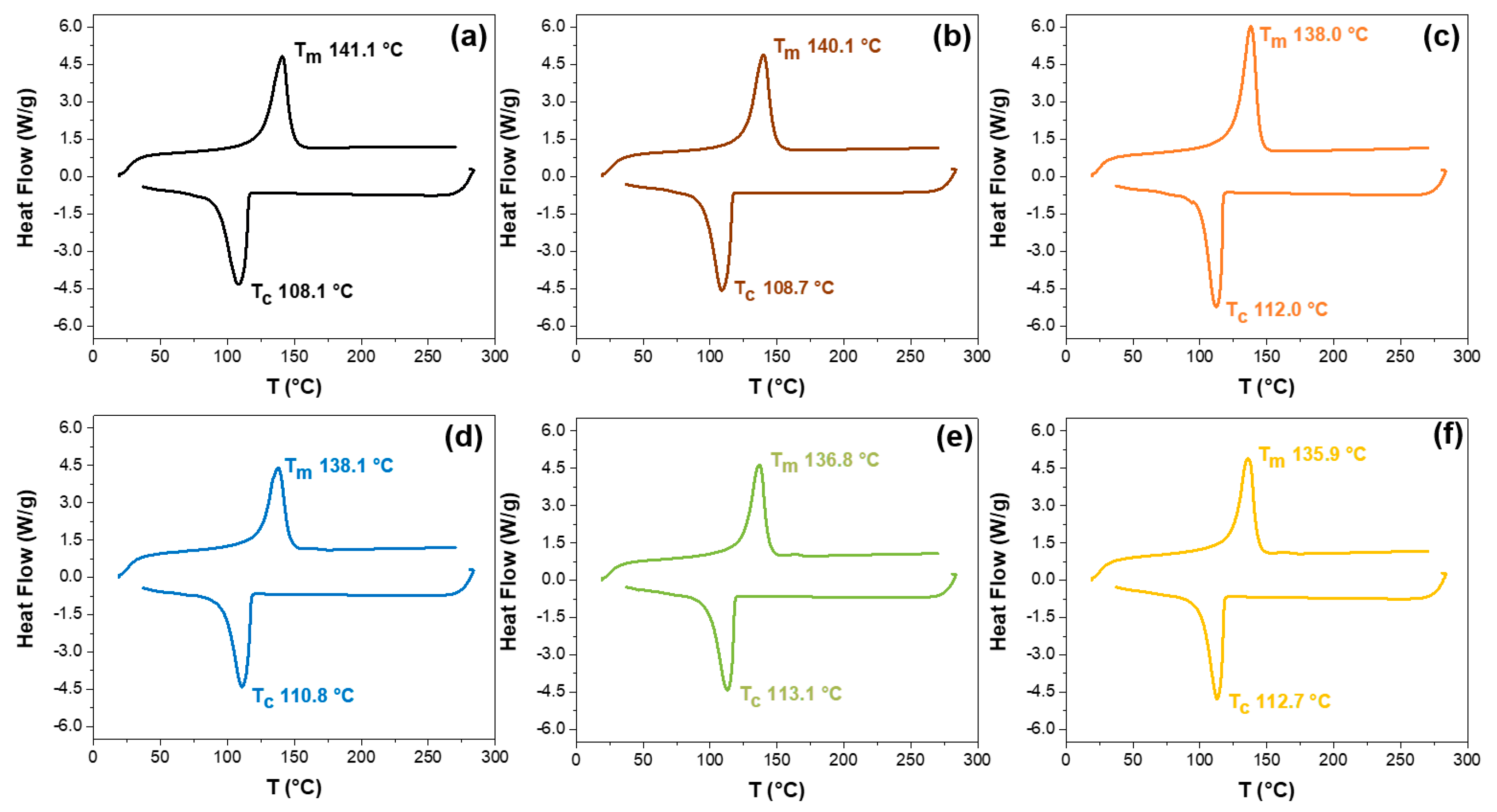
 ) HDPE, (
) HDPE, ( ) HDPE 0.5 wt.% Cu-NPs, (
) HDPE 0.5 wt.% Cu-NPs, ( ) HDPE 0.7 wt.% Cu-NCs, (
) HDPE 0.7 wt.% Cu-NCs, ( ) rHDPE, (
) rHDPE, ( ) rHDPE 0.5 wt.% Cu-NPs, and (
) rHDPE 0.5 wt.% Cu-NPs, and ( ) rHDPE 0.7 wt.% Cu-NCs. (a) TGA analysis and (b) maximum thermal degradation rate.
) rHDPE 0.7 wt.% Cu-NCs. (a) TGA analysis and (b) maximum thermal degradation rate.
 ) HDPE, (
) HDPE, ( ) HDPE 0.5 wt.% Cu-NPs, (
) HDPE 0.5 wt.% Cu-NPs, ( ) HDPE 0.7 wt.% Cu-NCs, (
) HDPE 0.7 wt.% Cu-NCs, ( ) rHDPE, (
) rHDPE, ( ) rHDPE 0.5 wt.% Cu-NPs, and (
) rHDPE 0.5 wt.% Cu-NPs, and ( ) rHDPE 0.7 wt.% Cu-NCs. (a) TGA analysis and (b) maximum thermal degradation rate.
) rHDPE 0.7 wt.% Cu-NCs. (a) TGA analysis and (b) maximum thermal degradation rate.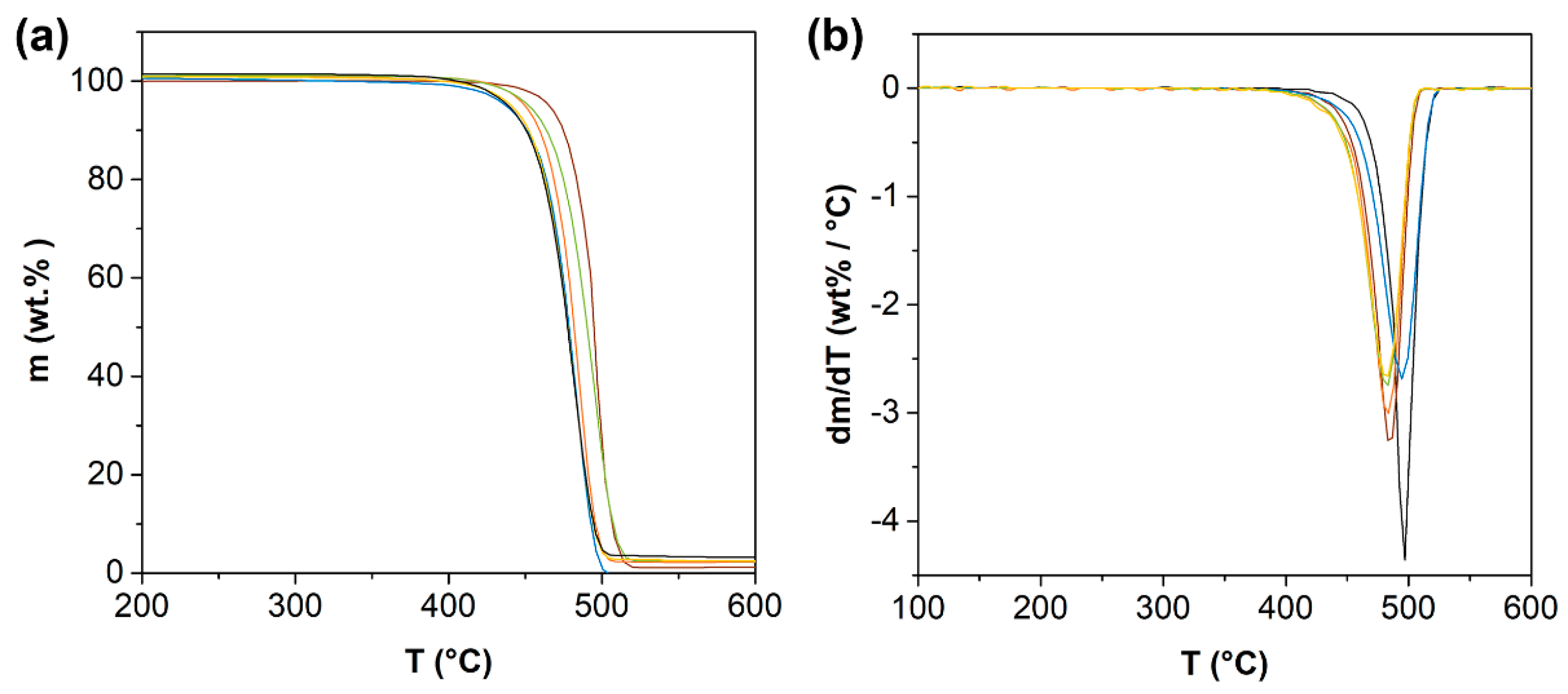
 ) HDPE, (
) HDPE, ( ) HDPE 0.5 wt.% Cu-NPs, (
) HDPE 0.5 wt.% Cu-NPs, ( ) HDPE 0.7 wt.% Cu-NCs, (
) HDPE 0.7 wt.% Cu-NCs, ( ) rHDPE, (
) rHDPE, ( ) rHDPE 0.5 wt.% Cu-NPs, and (
) rHDPE 0.5 wt.% Cu-NPs, and ( ) rHDPE 0.7 wt.% Cu-NCs.
) rHDPE 0.7 wt.% Cu-NCs.
 ) HDPE, (
) HDPE, ( ) HDPE 0.5 wt.% Cu-NPs, (
) HDPE 0.5 wt.% Cu-NPs, ( ) HDPE 0.7 wt.% Cu-NCs, (
) HDPE 0.7 wt.% Cu-NCs, ( ) rHDPE, (
) rHDPE, ( ) rHDPE 0.5 wt.% Cu-NPs, and (
) rHDPE 0.5 wt.% Cu-NPs, and ( ) rHDPE 0.7 wt.% Cu-NCs.
) rHDPE 0.7 wt.% Cu-NCs.
 ) virgin HDPE and (
) virgin HDPE and ( ) recycled HDPE samples: (a) E. coli and (b) S. aureus.
) recycled HDPE samples: (a) E. coli and (b) S. aureus.
 ) virgin HDPE and (
) virgin HDPE and ( ) recycled HDPE samples: (a) E. coli and (b) S. aureus.
) recycled HDPE samples: (a) E. coli and (b) S. aureus.
| Samples | |||||
|---|---|---|---|---|---|
| HDPE | 141.1 | 108.1 | 145.5 | 159.6 | 49.7 |
| rHDPE | 138.1 | 110.8 | 124.1 | 148.9 | 42.4 |
| HDPE-0.5 wt.% Cu-NPs | 140.1 | 108.7 | 165.7 | 166.4 | 56.6 |
| rHDPE-0.5 wt.% Cu-NPs | 136.1 | 113.1 | 143.2 | 144.6 | 48.9 |
| HDPE-0.7 wt.% Cu-NCs | 138.0 | 112.0 | 198.6 | 148.3 | 67.8 |
| rHDPE-0.7 wt.% Cu-NCs | 135.9 | 112.7 | 144.2 | 140.7 | 49.2 |
| Samples | D (xHD) | |||
|---|---|---|---|---|
| HDPE | 26.97± 0.5 | 18.86 ± 0.3 | 52 ± 1.89 | 59.3 ± 0.8 |
| rHDPE | 21.51 ± 0.9 | 4.46 ± 0.5 | 259.9 ± 43.5 | 57.9 ± 1.6 |
| HDPE-0.5 wt.% Cu-NPs | 28.03 ± 1.4 | 5.58 ± 0.3 | 126.7 ± 30.6 | 55.4 ± 2.1 |
| rHDPE-0.5 wt.% Cu-NPs | 26.43 ± 0.2 | 5.28 ± 0.04 | 140 ± 28.3 | 54.6 ± 2.8 |
| HDPE-0.7 wt.% Cu-NCs | 29.58 ± 1.2 | 6.25 ± 0.4 | 170 ± 14.1 | 57.2 ± 2.1 |
| rHDPE-0.7 wt.% Cu-NCs | 25.09 ± 1.6 | 5.02 ± 0.3 | 166.7 ± 46.2 | 57.6 ± 1.3 |
Publisher’s Note: MDPI stays neutral with regard to jurisdictional claims in published maps and institutional affiliations. |
© 2022 by the authors. Licensee MDPI, Basel, Switzerland. This article is an open access article distributed under the terms and conditions of the Creative Commons Attribution (CC BY) license (https://creativecommons.org/licenses/by/4.0/).
Share and Cite
Arcos, C.; Muñoz, L.; Cordova, D.; Muñoz, H.; Walter, M.; Azócar, M.I.; Leiva, Á.; Sancy, M.; Rodríguez-Grau, G. The Effect of the Addition of Copper Particles in High-Density Recycled Polyethylene Matrices by Extrusion. Polymers 2022, 14, 5220. https://doi.org/10.3390/polym14235220
Arcos C, Muñoz L, Cordova D, Muñoz H, Walter M, Azócar MI, Leiva Á, Sancy M, Rodríguez-Grau G. The Effect of the Addition of Copper Particles in High-Density Recycled Polyethylene Matrices by Extrusion. Polymers. 2022; 14(23):5220. https://doi.org/10.3390/polym14235220
Chicago/Turabian StyleArcos, Camila, Lisa Muñoz, Deborah Cordova, Hugo Muñoz, Mariana Walter, Manuel I. Azócar, Ángel Leiva, Mamié Sancy, and Gonzalo Rodríguez-Grau. 2022. "The Effect of the Addition of Copper Particles in High-Density Recycled Polyethylene Matrices by Extrusion" Polymers 14, no. 23: 5220. https://doi.org/10.3390/polym14235220
APA StyleArcos, C., Muñoz, L., Cordova, D., Muñoz, H., Walter, M., Azócar, M. I., Leiva, Á., Sancy, M., & Rodríguez-Grau, G. (2022). The Effect of the Addition of Copper Particles in High-Density Recycled Polyethylene Matrices by Extrusion. Polymers, 14(23), 5220. https://doi.org/10.3390/polym14235220







